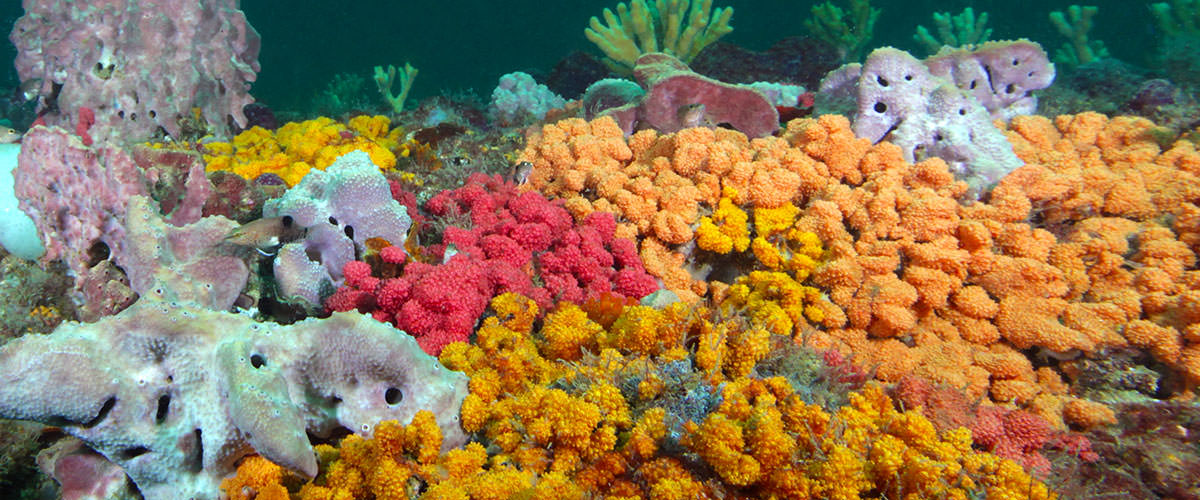
Click on individual links below to learn more about the immediate science needs for critical management issues. For a full list of management issues and science needs, please review the GRNMS Management Plan. To contact us about the science needs described below, contact the Sanctuary Research Coordinators.
-
Accoustic Impacts to Resources
Increased human activity in coastal waters produces greater inputs of anthropogenic noise into the marine environment. Many marine animals, including mammals, fish and invertebrates, use sound to communicate, navigate, and/or feed. It is unknown how anthropogenic noise impacts these sound cues used by marine organisms. Impacts to resources in Gray's Reef National Marine Sanctuary (GRNMS) due to underwater noise warrant attention and research. (Updated 11/12/2014)
-
Benthic-Pelagic Coupling
Recreational fishing activities in Gray's Reef National Marine Sanctuary frequently target large pelagic species. Managers need to understand how the extraction of pelagic species impacts bottom associated species. (Updated 11/12/2014)
-
Biodiversity
An estimated 200 species of fish have been recorded at Gray's Reef National Marine Sanctuary (GRNMS). Several species of marine mammals, sea turtles and sea birds all utilize the sanctuary at various times of the year. Diversity at GRNMS is very high compared to shelf sites at similar depths elsewhere, but there are no baseline data to determine how it may be shifting. In order to adequately protect Gray's Reef National Marine Sanctuary resources, managers need to understand biodiversity in the sanctuary and how it might be changing due to natural events and anthropogenic activities. (Updated 11/12/2014)
-
Climate Change and Ocean Acidification
Climate change is predicted to affect physical oceanographic and biogeochemical processes within the Gray's Reef National Marine Sanctuary (GRNMS) and is being regarded as a cross cutting theme for the sanctuary's monitoring and research programs. Climate change is having significant effects on sea temperature, pH, sea level, and currents potentially increasing storm intensity, flooding and droughts. Sea level rise can cause coastal erosion, wetland loss, alteration of species assemblages and distributions, impacts on infrastructure flooding and island re-sizing, and can have groundwater implications - all of which can potentially affect the resources of GRNMS. (Updated 11/12/2014)
-
Climate Historical Ecology
When Gray's Reef National Marine Sanctuary (GRNMS) was established in 1981, little was known about the ecological integrity of the site. Current efforts focus on characterizing the present conditions of the ecosystems in the sanctuary, however studying their early state remains to be done. In order to accomplish their stewardship mission, GRNMS's managers need to fully understand the past conditions of biomass and biodiversity of the sanctuary. Estimating baselines informs managers as to the suite of factors, anthropogenic and/or natural, that may have caused changes to the current conditions of the ecosystems and, in some cases, to lose their resiliency. Baselines can thus measure how successful the sanctuary is in protecting the ecological integrity of the site. Baselines are also an indication of the potential productivity of the sanctuary allowing managers to set realistic management goals and restoration targets. (Updated 11/12/2014)
-
Fish Spawning
Gray's Reef National Marine Sanctuary (GRNMS) is home to many important commercial and recreational fish species. Managers need to understand the reproductive life cycles and the associated habitat needs of fish spawning aggregations within GRNMS in order to adequately protect those resources. (Updated 11/12/2014)
-
Habitat Change
Observations in Gray's Reef National Marine Sanctuary and at other live bottom areas in the South Atlantic Bight indicate that significant movement of sand occurs along the ocean bottom on a seasonal basis. In addition, wave action during significant storm events is likely to cause changes to hard bottom habitats and communities. Managers need to understand the impacts that sand movement and wave action have on the unique habitats and other resources of the sanctuary. (Updated 11/13/2014)
-
Invasive Species
As one of the largest near-shore live-bottom reefs of the southeastern United States, Gray's Reef National Marine Sanctuary (GRNMS) supports fish and benthic communities that are recognized nationally and internationally. The relatively warm year-round bottom temperatures make GRNMS susceptible to the impacts of invasive species, particularly as climate change continues. Invasive species in GRNMS need to be tracked, monitored, and studied so that impacts to resources can be assessed and potential management actions, such as eradication, can be evaluated. (Updated 12/16/2014)
-
Research Area Efficacy - Fishing Impacts
In 2011, approximately one-third of Gray's Reef National Marine Sanctuary (GRNMS) was designated as a Research Area closed to recreational fishing and diving. The Research Area provides a place where scientists can study the impacts of human activities, including bottom fishing, as well as monitor and study impacts of climate change and natural events such as hurricanes and droughts on the sanctuary's marine resources. The sanctuary must also investigate the efficacy of the Research Area itself as a means for conservation of the unique marine resources in the sanctuary. (Updated 12/16/2014)
-
Socioeconomics
Managers need to understand the socioeconomic importance of the resources of Gray's Reef National Marine Sanctuary (GRNMS) in order to inform management decisions. (Updated 11/12/2014)

